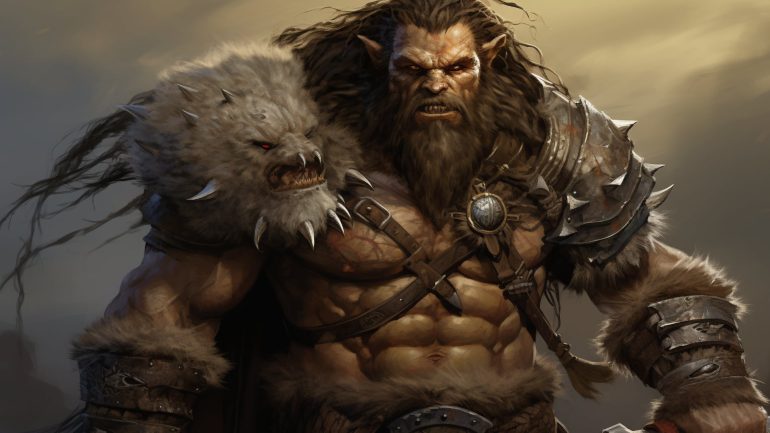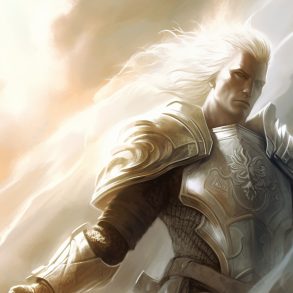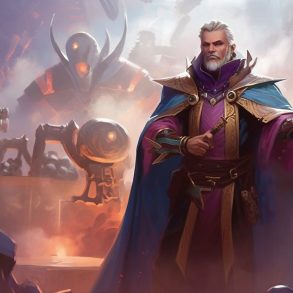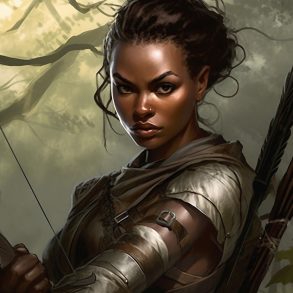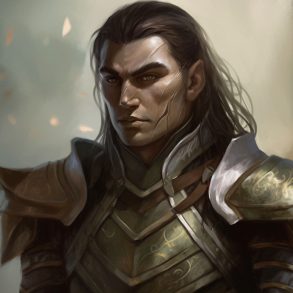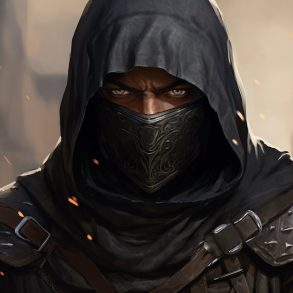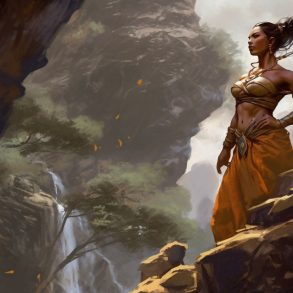Ever since you were a child you’ve drawn your strength from within, a primal roar your battle cry as you engaged your siblings foes. Years later, your battle-scarred body is a honed weapon to channel your primal rage through, striking fear in the hearts of your enemies. You want to play a Barbarian, so grab your protein shake, and let us show you the ropes.
In this Barbarian DnD 5E guide, we’ll train you on your options as a Barbarian, as well as supportive choices you can make to build your character to achieve what you want. Whilst reading through this guide, you may find our articles on DnD terms and list of DnD books (and their common abbreviations) helpful.
This Barbarian DnD 5E guide will evaluate each option for the Barbarian on a scale of 1-5 — this is a rating of the abilities’ potency and overall usefulness, primarily focusing on combat where appropriate. That said, I will still evaluate everything, hopefully, to aid you to weigh any choices you might be considering at a glance, helping you know what to expect and make changes accordingly if desired. The rating scheme is:
1 – Usually a bad choice, to be avoided
2 – Below average, this can apply to powerful but very niche abilities
3 – Average to Good, you won’t go wrong with it
4 – Very good
5 – Amazing, a must-have if there is such a thing
Be sure to check our other DnD 5E class guides: Artificer 5E guide, Fighter 5E guide, Monk 5E guide, Paladin 5E guide, Ranger 5E guide, Rogue 5E guide, Sorcerer 5E guide, and Warlock 5E guide.
Changelog
Version 1.3
Version 1.2
- Added Spelljammer races
Version 1.1
- Added Mordenkainen Presents: Monsters of the Multiverse races
Version 1.0
- Initial guide
Disclaimer
This rating system exists to best help you understand the effectiveness of all the options available to the class for you to build and enjoy your character. Remember though, your fun comes first; it’s actually very difficult to build a character that is entirely bad in DnD 5E, so if you have a concept that doesn’t rate highly, you might still have fun playing it. This is a guide, not a contract written by Asmodeus. Let it advise you and not force you away from your own ideas.
It’s recommended to have your book/PDF/DnD Beyond page open to reference and follow along with the guide.
Table of Contents
Barbarian 5E Class Abilities Guide
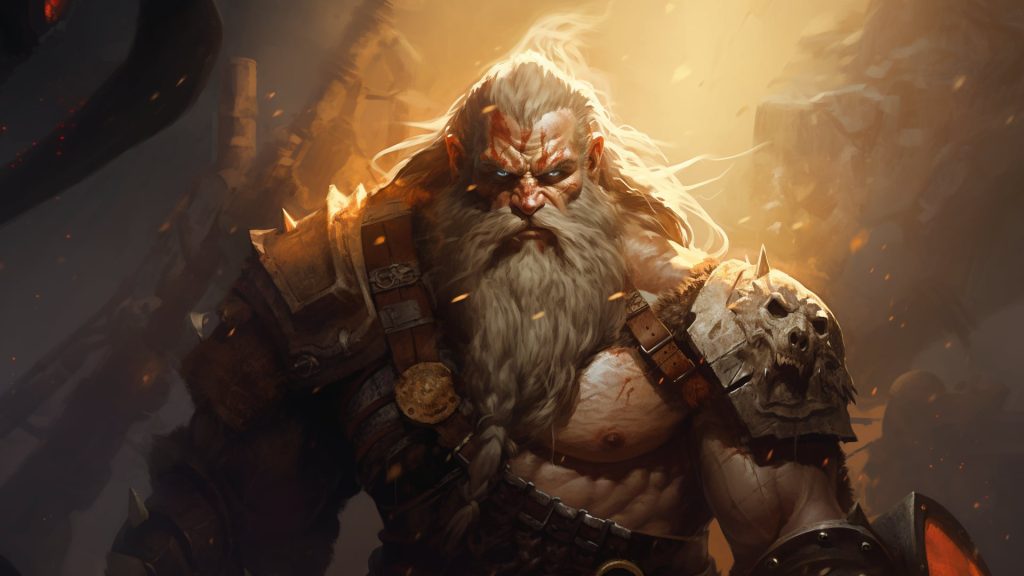
Hit Dice 5 – The largest Hit Die size available, a d12 is exclusive to the Barbarian and provides them with a large number of hit points to reinforce their role as a tank, and theme of being the toughest martial.
Proficiencies
Armor 4 – Ironically you have proficiency with every armor except heavy, the only type to have a Strength requirement. Medium armor and shield proficiency give a competitive AC, but most Barbarians won’t be fighting for the highest AC in the party.
Weapons 5 – You have proficiency with all weapons, whilst you are heavily motivated to just use melee weapons, it doesn’t hurt to carry a longbow with you for the times you’re caught out at range.
Tools 1 – You’re far too angry to learn any tool that isn’t designed to smash evil’s face, which are called weapons.
Saving Throws 4 – Constitution is a save attached to not only significant damage but also nasty debuffs, making it a great save to have. Strength is often the precursor to bad things happening to you, like attacks at advantage and being digested. Part of what makes these saves so good on a Barbarian is the coverage of Dexterity saves that Danger Sense provides.
Skills 4 – You have some options to branch out your utility, but still have the choice of the excellent Perception and the potentially very useful Athletics, which combined with your high Strength and Rage benefits, you can excel at.
Rage 5 – The bread and butter of a Barbarian with a damage boost, some damage resistances, and advantage on Strength related checks and saves. This feature takes some getting used to and is awkward at first, unless your table has few encounters per day, you will have to judge which combats to Rage in and which to not. This problem goes away as you gain levels and have more uses of Rage to spend each long rest, as long as you’re conscious of the drawbacks this is a very potent ability.
Unarmored Defense 4 – Having a decent AC when you’re without armor, for example, if you’re sleeping or have been captured, can be very valuable. As long as you have a shield the formula works well enough to be competitive and has a high potential of 22 AC before your 20th level ability, be aware though: using this feature as your primary method of AC will increase the MADness of the class. You’ll save gold not having to buy better armor though, which can be helpful depending on your campaign and shopping habits.
Reckless Attack 4 – A double-edged greatsword of an ability, being able to give yourself advantage at-will is amazing, but the heavy cost of advantage against you is something you need to consider carefully. This can facilitate builds that require higher accuracy, such as with the Great Weapon Master feat, but recklessly using this can easily lead to making a new character.
Danger Sense 5 – Fantastic defensive ability that mostly makes up for the lack of Dex save proficiency, it won’t help against hidden or invisible dangers though.
Extra Attack 5 – The quintessential martial damage increase, this pairs perfectly with the additional damage from Rage, and if you’re interested in shoving/grappling with the Rage benefits this allows you to do both, or one whilst still attacking.
Fast Movement 5 – Additional movement is always welcome, 10ft is a significant speed boost that allows you to close into melee more reliably, or get away more effectively if things go badly! This gets a 5, as it is not attached to Rage and comes alongside the already great Extra Attack.
Feral Instinct 5 – Advantage on initiative is a fantastic boost to compensate for your middling Dex, in the same vein as Danger Sense helping your Dex saves. Protection against being surprised is a nice bonus, but may not come up often depending on your DM.
Brutal Critical 2 – Additional damage is always nice, but the only way to increase how often you get crits built into the Barbarian is Reckless Attack, and the actual benefit you gain varies greatly by the weapon used and luck. This is certainly something you can build around but as a general damage feature, it’s lackluster. This adds additional dice at 13th and 17th level as well, meaning that your higher-level Barbarian might have to seek out damage increases from their subclass instead.
Relentless Rage 5 – Shrugging off death makes you feel like a Barbarian and the DC resetting every rest means you will be able to take an outlandish amount of punishment on any given adventuring day. Well, as long as you don’t roll a 1 on this saving throw…
Persistent Rage 4 – Not exciting, but this shores up a weakness in your Rage-based defenses allowing you to keep Rage going if you can’t get to another target in time, or get struck with something like Hold Person. Some would argue inner peace isn’t always the answer, just saying.
Indomitable Might 2 – A niche ability which feels more like a ribbon than a higher-level ability, most useful for a grappling Barbarian, but will come in hand occasionally for most.
Primal Champion 5 – Although not the most exciting–surely, you can Insight the theme here–certainly very potent and notable for allowing you to smash through the normal ability score limit of 20. To get the most value from this capstone you should have taken both Strength and Constitution to 20 first, however, this is a heavy investment in the meantime and isn’t really necessary.
Barbarian 5E Optional Class Features (TCoE) Guide
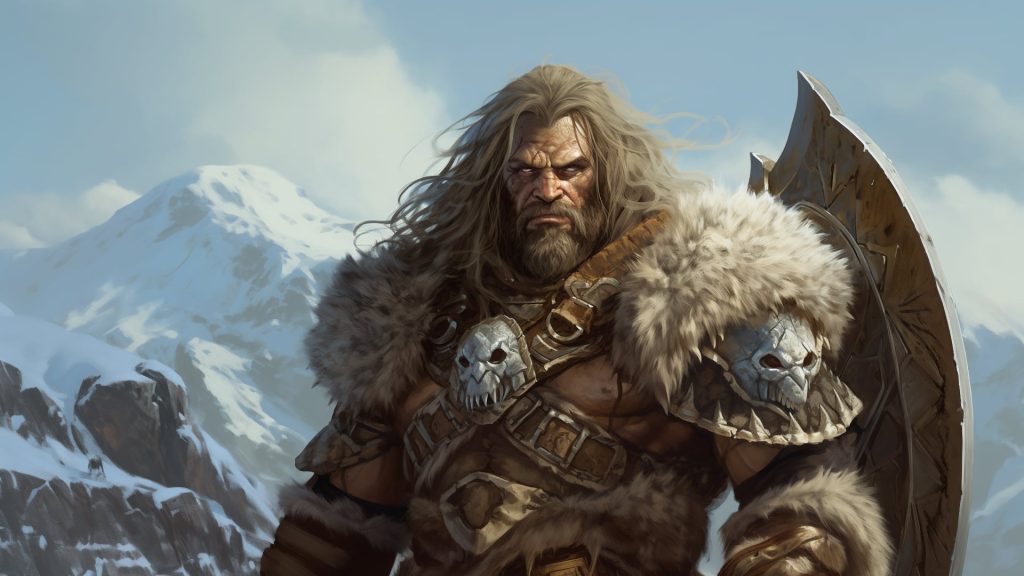
Both optional class features available to the Barbarian are additions to the class, rather than modifying or replacing an existing feature, and will be covered in this section.
Primal Knowledge 5 – One common criticism of the Barbarian is a lack of out of combat features, the addition of more skill proficiencies goes a long way to help this. The reason this gets a 5 is that it is both an addition, and comes at levels 3 and 10, where you get other features.
Instinctive Pounce 5 – A problem Barbarians can face as a melee-centric class is not being able to close the distance to a target. Fast Movement helps to deal with this to some extent, but an additional 20 feet, on average, of movement on your first turn can significantly reduce the chances of this happening.
Barbarian DnD 5E Stats Guide
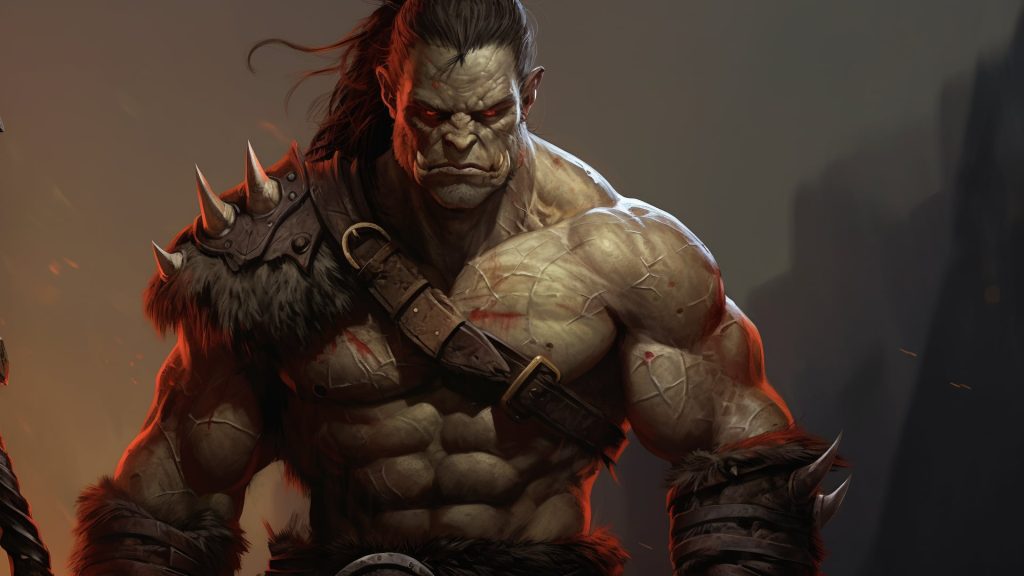
The Barbarian class is heavily pigeon-holed into using Strength as its primary attribute, with a need for some degree of Dexterity for AC and Constitution for hit points and potentially AC. This all adds up to a mildly MAD character, although a character’s need for any one of those stats varies greatly depending on how they’re built. For example, a player who doesn’t want to invest in Dexterity for their AC could choose to use a shield to compensate.
For a typical Barbarian starting with a Strength of 16, Dexterity of 14 and Constitution of 14 or 16, would give you a strong base for your character, but you don’t need to have those stats that high to be effective and have fun.
Strength 5 – Your primary stat, ideally this should start at a 16 and be raised to 20 when possible, or 18 if you plan to use an ASI for a feat early on. As Rage and Reckless Attack only work with Strength-based attacks, you’re going to be using this stat constantly so it pays to invest in it. On the plus side, a high Strength combined with Rage makes you an excellent grappler and shove-er, for those that like control in their Barbarians.
Dexterity 4 – A powerful stat for all characters with its ties to initiative, various skills, and how common Dexterity saving throws are, this is wanted for AC on a Barbarian. For most builds leaving this at a 14 is more than adequate and gives you a viable chance with a bow if you need to attempt ranged combat.
Constitution 5 – The Barbarian in some ways is defined by a larger amount of hit points, Con is essential for this, as well as providing AC if you don’t wear armor, and saving throws to not die once you get Relentless Rage. Try to have no lower than a 14 here, but ideally, 16 to start out and then as high as you can afford to go afterward is recommended.
Intelligence 1 – The only reason to invest in this is roleplay or if you want to be good at Int-related skills.
Wisdom 3 – Very useful for increasing your perception, it is recommended to have a positive, even just a +1, in this stat to assist with Wisdom saving throws that can remove you from combat and end your Rage.
Charisma 2 – Only slightly better than Intelligence for you and that’s only because Charisma skills typically come up more often than Int ones. If you’re planning on multiclassing into Paladin for Divine Smite, this is essential and needs at least a 13, otherwise whatever you have leftover will do here.
Barbarian DnD 5E Primal Paths (Subclasses) Guide
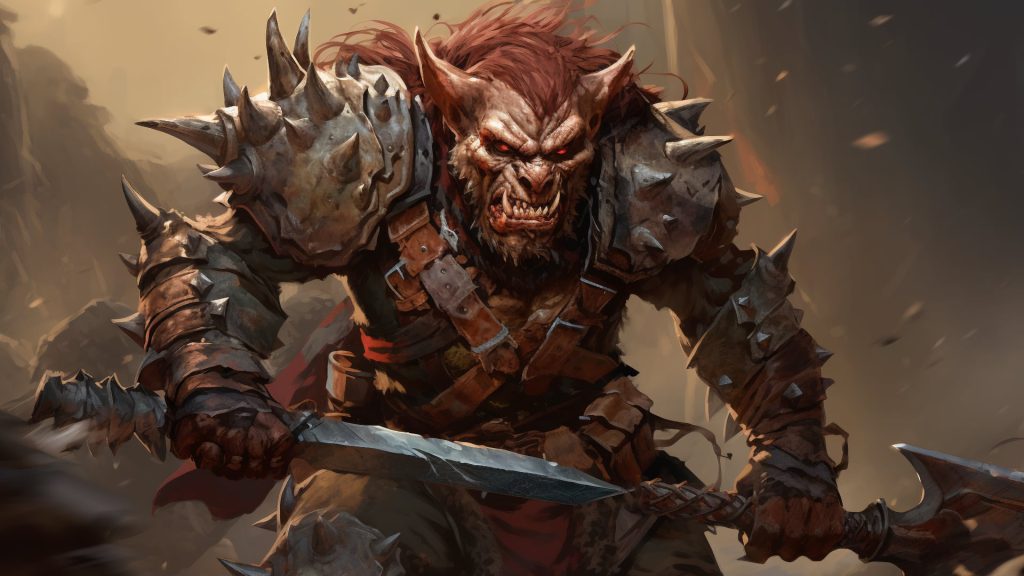
How a Barbarian plays can be greatly influenced by the subclass you choose as they often provide abilities that allow you to fully step into a role you want, such as tank or damage dealer. Uncommon for most classes, the subclasses for the Barbarian often involve different choices to make within the subclass, this allows a great deal of customizability for your character builds.
Totem Warrior
This Barbarian has a spiritual connection, choosing an animal spirit to guide and inspire them in battle. Arguably the most well known Primal Path for the Barbarian is also the most customizable, allowing you to pick a different totem option at every level you gain a feature, contrary to a common misconception that you’re locked into your 3rd level choice for all other levels. Notably, this is one of only two Barbarian subclasses to get access to any spells.
Spirit Seeker 4 – Whilst situational, this is a great boost of utility that is otherwise lacking in the Barbarian class and compliments the natural spiritualism of the subclass.
Totem Spirit 3rd level – We will now go through all of the totem options, options that were added in the Sword Coast Adventurer’s Guide will be denoted by [SCAG].
Bear 5 – The popular choice for good reason, expanding your Rage resistances to every damage type except psychic is a huge boost to your durability, effectively doubling your hit points.
Eagle 4 – For the skirmishing Barbarian, disadvantage isn’t as nice a skirmishing ability and denying opportunity attacks altogether like the Mobile feat, but should help protect you. The ability to dash as a bonus action whilst raging is great for both skirmishing, closing distance to your next target, and running away when things have gone very badly.
Wolf 3 – Potentially very powerful, but entirely dependent on the type of party members you have and even by what the terrain is like and how many enemies there are. This is best leveraged in a party that has a GWM user and a Rogue, as they’re classes that rely on accuracy more than most.
Elk 2 [SCAG] – Faster movement speed is always nice, but unlike Eagle, this totem doesn’t give you any additional tools to use that movement without getting hit by an opportunity attack. This can be valuable for certain builds, like a Barbarian that takes the Mobile feat, and would lead to speeds that would make a Monk blush.
Tiger 1 [SCAG] – This is so thoroughly underwhelming and niche for an in combat ability, it could have at least given you a pouncing ability to knock enemies prone or do more damage.
Aspect of the Beast 6th level – These abilities are primarily utility features that function even when you’re not raging. Again it’s important to note that you can choose any option here, you’re not stuck with what you chose at 3rd level.
Bear 3 – Very campaign-specific, but pairs well with your high Strength score to give you a very high carrying capacity. Most useful for tables that do a lot of dungeon crawls and need to haul their treasure out without the aid of animals.
Eagle 4 – You become the party’s spyglass, the best part of this ability is preventing disadvantage to Perception checks in dim light. This is a minor improvement for races without darkvision, but for those with darkvision, it makes your Barbarian see as well within their range as a Warlock would with Devil’s Sight in mundane darkness.
Wolf 2 – Very table dependent as some tables don’t use travel rules at all, and unfortunately, you need to get Stealth proficiency from your race in order to make the most out of moving stealthily.
Elk 2 [SCAG] – Another niche ability as it requires the travel rules, but for those that use them frequently, it’s a huge boon, essentially cutting travel time in half.
Tiger 5 [SCAG] – Two additional skill proficiencies, especially Stealth, makes for a fantastic ability that stands out among its animalistic peers. Meow indeed.
Spirit Walker 3 – An exceedingly powerful and thematic utility ability, allowing you to cast a 5th level spell only one level later than fullcasters that get it can. This only gets a 3 as it’s limited to wild areas and the information it can provide you varies greatly in usefulness.
Totemic Attunement 14th level – Just like the 3rd and 6th level abilities you’re free to choose any of the following options, no matter which totem you chose at those previous levels.
Bear 4 – A great defensive ability against melee opponents this doesn’t quite get a 5, however, because immunity to the frightened condition is not uncommon at higher levels.
Eagle 5 – Gaining a flying speed is a huge boost to your mobility, even if it is only on your turn. This pairs excellently with Fast Movement, the 3rd level Elk option, Mobile, and any race that has a higher than 30ft movement speed.
Wolf 2 – Knocking a creature prone without a saving throw is very nice, but in Tier 3 Huge and above enemies shouldn’t be too uncommon and it requires your bonus action, which you may have found a use for already, such as Polearm Master.
Elk 3 [SCAG] – In essence, this is a charging attack, it allows you to knock a large or smaller creature prone like the Wolf ability, but also allows you to do a decent amount of damage to that creature at the same time. This only gets a 3 as Strength is typically a strong monster saving throw.
Tiger 2 [SCAG] – Bonus action attacks are nice, but needing to move 20 feet beforehand is an unnecessary restriction, especially when the attack doesn’t do any additional damage or push the creature, etc.
Berserker
A subclass focused on channeling Rage into unstoppable violence to meet the ends of the Barbarian using it. This subclass is widely discounted because of the penalty associated with the 3rd level ability, but it is still certainly playable. If you are hesitant but want to play this subclass then make sure to work with your DM to perhaps alter or remove that penalty.
Frenzy 2 – A bonus action attack is a source of significant additional damage, however, gaining exhaustion for using your subclass ability not only feels bad, but the power of the feature also doesn’t warrant a penalty to begin with. Besides gradually reducing your overall effectiveness, the other negative here is that you can’t actually make that attack on the turn that you enter Rage, which is poor design. All of that said, the damage potential of the bonus attack is too high to rate this a 1, and to make the most out of this ability you should use larger damage die weapons.
Mindless Rage 5 – An excellent defense for a Barbarian that helps cover their poor Wisdom saves and prevent losing Rage due to being debuffed by the enemy.
Intimidating Presence 1 – This ability is just plain bad, not only do you have to give up your entire action to trigger it and subsequent actions to keep the effect going, but it suddenly incorporates your Charisma modifier for a single ability, ten levels into your character. The opportunity cost is too high, the MADness is unnecessary and holds the reliability of the feature back, and the end result is a condition that’s easy to impose and doesn’t impact a lot of monsters at all due to immunity.
Retaliation 4 – More damage to double down on the theme of this subclass, getting additional attacks is always good, but without some additional damage or rider effects this doesn’t warrant a 5. Much like Frenzy, this is worth what you make of it in terms of the weapon and additional abilities you use with the attack.
Battlerager
An unusual subclass that focuses on the use of a specific kind of armor, spiked armor, the Battlerager is restricted to dwarves only by RAW, however, it is worth noting that a similar restriction on the Bladesinger Wizard was removed when it was reprinted, so discuss with your DM if you’d like to play another race. Spiked armor is medium armor that gives disadvantage on Stealth and an AC of 14 + Dex modifier, maximum of +1. This subclass is often dismissed due to the reliance on armor that isn’t competitive with half plate for AC, perceived power level, and being published in the SCAG but not later reprinted in XGtE or TCoE.
Battlerager Armor 4 – Despite the low damage die, the damage brought to the table by this feature is the same as the PAM feat’s bonus action attack. The majority of the damage here is actually delivered by the Rage damage bonus and Strength modifier, both of which scale to some degree. The icing on the spikey cake here is the automatic damage when grappling, adding additional incentive to lock down an enemy. This doesn’t tip over into 5, as there’s no built-in way to make this damage magical, and ideally, in later levels, the damage of the bonus action attack would scale a little. Similar to the Berserker you can not make this attack on the turn that you rage. If you’re playing a higher level game where resistance/immunity to nonmagical bludgeoning, piercing, and slashing is fairly common then the rating for this ability drops severely.
Reckless Abandon 3 – Reducing the risk of using Reckless Attack is a huge boon, unfortunately, this can’t push above a 3 as the temp hp is relatively minor, although they are deceptively effective if the damage is bludgeoning, piercing, or slashing.
Battlerager Charge 2 – Dashing as a bonus action is always nice, but without allowing you to make your bonus action attack as part of the Dash, this ability is directly at odds with your core subclass feature. This is still useful to close distance to a new target, or potentially flee, but it’s niche with a high opportunity cost.
Spiked Retribution 2 – 3 damage at 14th level and higher is very small, and in addition to that the damage is likely to be resisted or completely ignored at such a high level.
Ancestral Guardian
Steeped in a tradition of revering their ancestors, this subclass focuses on tanking by protecting party members and making sure that the enemy is incentivized to hit you instead of them. It’s recommended to not delay your Strength score progression with this subclass, as the 3rd level feature relies on you hitting a creature, so accuracy is key. Interestingly, this subclass is one of the few for the Barbarian that can be played at range. This is done by using Ancestral Protectors to give the monsters disadvantage on their attacks against everyone else, whilst you hide in the backlines.
Ancestral Protectors 4 – A fantastic tanking ability that really encourages the enemy to attack you, rather than focus fire the squishy teammates that you’re protecting. This only gets a 4 because it can only affect one creature at a time, unlike the Armorer Artificer’s Thunder Gauntlets.
Spirit Shield 5 – Being able to reduce damage to your allies is a great ability and there’s just enough scaling here to keep the ability relevant no matter what level you are.
Consult the Spirits 4 – A welcome utility feature for the Barbarian that is very in-theme with being in touch with your ancestral spirits. This is only a 4 as you have to pick which spell you want to use per rest, if you could cast both of them per short or long rest then this ability would be a 5. It’s worth noting that your Spirit Shield increases to 3d6 at this level in addition to gaining this feature, and this is factored into the rating.
Vengeful Ancestors 5 – An amazing upgrade to Spirit Shield, 4d6 force damage that hits automatically is roughly equivalent to casting Magic Missile at 2nd level, on top of reducing the damage your ally takes, and all as a reaction!
Storm Herald
When a Barbarian’s primal Rage meets the primal forces of nature, you get a Storm Herald, a warrior that channels the forces of nature in an aura around themselves. The aura given by this subclass gives a variety of abilities, from damage to control, with a sprinkling of support in between.
Storm Aura 3rd level – Note that whilst there are multiple options, unlike the Totem Warrior, you must use the same choice for all abilities.
Desert 3 – Automatic damage is always great, this doesn’t warrant higher than a 3 as the aura is a low amount of damage over the course of the day, it can hurt your allies, and fire damage is one of the more commonly resisted/immune to damage types for monsters.
Sea 2 – Using your bonus action to inflict only 1d6, save for half, is okay at first but very quickly becomes lackluster, with the scaling being too little at too high a level to really keep this competitive. This is worth a 2 instead of a 1 as lightning is generally a good damage type and the option of using a Dexterity saving throw instead of targeting AC is nice for tougher enemies.
Tundra 3 – Giving yourself and other party members temp hp is always useful, especially as they may be doubled by your Rage. Unfortunately the amount of temp hp handed out is extremely few, and the aura itself is pretty small, really limiting the usefulness of this ability.
Storm Soul 6th level
Desert 3 – A damage resistance, protection from an environmental hazard, and a utility ability that doubles as a neat party trick. There’s nothing bad here, but there’s nothing standout good either.
Sea 3 – Similar in a lot of ways to the Desert option, the ability to breathe and swim is great for certain environments but is entirely dependent on where you’re adventuring.
Tundra 3 – Possibly the best generic option of the three, you could make use of the ice generation ability in creative ways although it’s a shame that the ice only lasts for one minute.
Shielding Storm 2 – Sharing your resistance is great, but a single resistance is always going to be niche unless your campaign has a clear theme in terms of the damage you are being subjected to.
Raging Storm 14th level
Desert 2 – The additional damage is nice, but on a successful save they only take the damage from your 3rd level ability and it’s still fire damage.
Sea 3 – Strength is normally a strong save for a monster, but being able to weaponize your reaction and knock a creature prone without any size restrictions is very good.
Tundra 2 – Similar to the Sea effect for this level, but unless one side is actively attempting to flee or the monster is trying to attack the backline, reducing movement speed for your bonus action isn’t as potent as knocking a creature prone.
Zealot
What kind of Barbarian doesn’t fear death? The kind that doesn’t have to reimburse the Cleric for reviving them! This subclass delivers a substantial damage increase, as well as outstanding durability and unwillingness to stay dead.
Divine Fury 5 – This is a significant damage increase that will scale well throughout your career, as well as giving you access to radiant (or necrotic) damage, which is uncommon for a Barbarian. Radiant is the recommended choice for the damage type unless you’re planning on storming Mount Celestia at some point in your campaign.
Warrior of the Gods 5 – Almost a ribbon ability, removing the gold cost from reviving you can really change how you play in combat, providing you have a spellcaster capable of bringing you back of course!
Fanatical Focus 5 – A significant boost to your save-based defenses, and if you lose your Rage for any reason you can even use it more than once per combat.
Zealous Presence 4 – A very powerful support feature that can really turn the tide of a combat, this doesn’t get a 5 because it doesn’t affect you and is only useable once per long rest, whilst this is powerful it isn’t quite that powerful.
Rage Beyond Death 5 – The encapsulation of being an unkillable Zealot, this ability works excellently with the Barbarian’s Relentless Rage feature to make you insanely difficult to kill.
Beast
If you’re interested in playing a werewolf-type character or are a fan of the Order of the Lycan from Matt Mercer’s Blood Hunter class, then this is the Barbarian for you. This subclass is very customizable on the fly rather than during level up, this is because you can decide which natural weapon you use every time you enter Rage, with each weapon giving a different type of benefit.
Bite 2 – A very niche weapon, being a 1d8 it’s not giving you a damage boost, but the amount of healing it provides is very small and only applies if you’re under half health. On the positive side you can wield a shield whilst using this weapon with no downside, but to get the most out of this ability you would want to use a larger damage die weapon like a greataxe for your second attack. Ideally, this would apply to more than one attack per turn, or not be limited by being under half your hit point maximum.
Claws 5 – While they may only be 1d6 weapons, the strength of the claws is giving you an additional attack which gives you another opportunity to leverage your Rage damage and high Strength modifier. If you’re looking to get even more out of the claws, you can use a larger weapon like a greatsword, as you only need to use your claws for one attack in order to gain the additional attack. It may also be possible to make a bonus action attack with the claws using the two-weapon fighting rules if you take the Dual Wielder feat, but be sure to check with your DM first as not all agree on this interpretation of the rules.
Tail 5 – A great defensive option, the reach property combined with Fast Movement allows you to be an effective skirmisher, and the reaction gives you the potential for very high AC if combined with a shield.
Wild Magic
Some players gravitate towards the chaotic fun of wild magic, be it the Wild Magic Sorcerer, or the Wand of Wonder magic item, if those interest you or if you’re just looking for a more whimsical Barbarian, then look no further. Due to the random nature of the subclass, it’s a little hard to plan around, but it’s effective and fun. One criticism of this subclass is that it doesn’t scale very well, it’s mostly all about the Wild Magic table, but the table has no built-in scaling for later levels.
Magic Awareness 2 – A thematic ribbon ability, this gets a 2 rather than a 3 as it’s going to be very niche in application.
Wild Surge – Rather than rating the overall ability, instead we will rate each option you could potentially roll on the table.
1 3 – This can damage a lot of enemies and the temporary hit points you get can go far with your resistance, but relying solely on 1d12 can be very swingy for example, you may get a 10 but you may also just get a 1 or 2 and there’s no damage on a successful save. It’s also a shame that this only triggers when you initially use Rage, you can’t use it on subsequent turns as a bonus action like other entries on the table.
2 5 – Essentially this is like being able to cast Misty Step for free every turn, but without the limitations of casting a spell. Excellent for skirmishing, chasing down enemies and, looking cool.
3 2 – An odd one, this is a delayed AOE with small damage and no damage on a save. This could come in handy and any additional damage is welcome, but it’s not something I’d be excited to roll.
4 2 – Changing your weapon damage to force is great, being able to use two-weapon fighting with a great axe in one hand is hilarious, but the throwing mechanic is clunky at best. As the weapon only returns to you at the end of your turn, you can only throw it for one of your two attacks once you have Extra Attack.
5 5 – Automatic force damage is excellent and can really add up if the creature attacking you has multiattack, or if you’re being attacked by multiple creatures.
6 4 – Raising the AC of yourself and party members is great, but with only a 10ft range this doesn’t quite make a 5.
7 5 – A great debuff for your enemies, this is pushed into being a 5 as the difficult terrain won’t affect you or your allies.
8 5 – Both a ranged option and a debuff that you can do every turn as a bonus action, the blinded condition can give you and your allies advantage on attacks, as well as allowing you to walk away without an opportunity attack.
Bolstering Magic 5 – A great mix of buffs for the party and yourself, this is one of the few ways to facilitate another character regaining spell slots that can allow you to give some additional longevity to your party’s casters. The increase to attack rolls can help offset the penalty from Great Weapon Master if you’re looking to enhance yourself.
Unstable Backlash 2 – Whilst this could be helpful, you may also be trading one of the better options for something more lackluster or situational. For example, if you roll the difficult terrain option, that isn’t going to help you in the current situation until your turn at best.
Controlled Surge 2 – This makes your subclass more reliably helpful, but feels a little disappointing. At the very least this should have included some scaling for the damaging options on the table, the 1d6 options especially would be aging very poorly by this level.
Barbarian DnD 5E Race Choices Guide
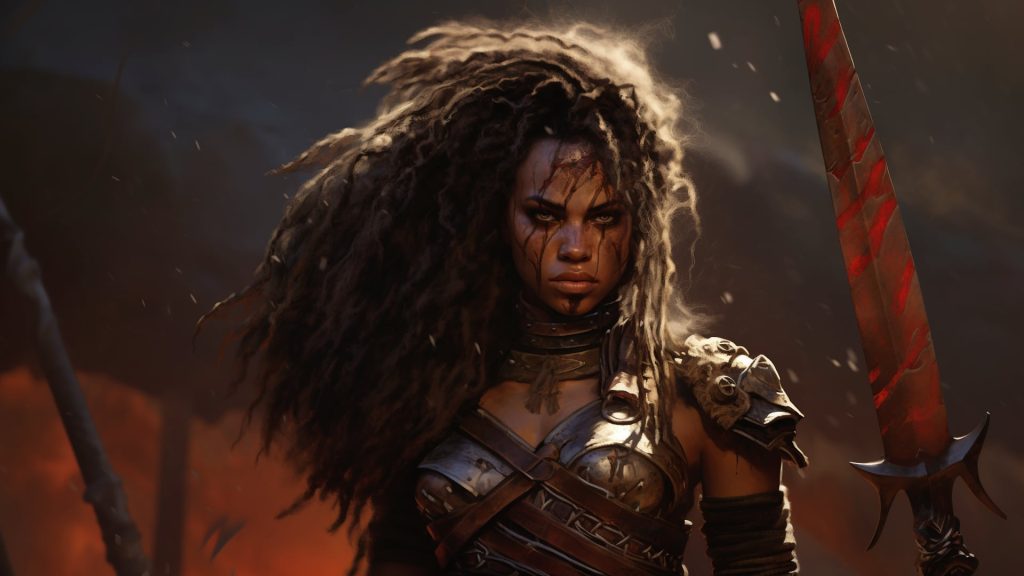
Races are good places to pick up abilities for certain character concepts, so if you’re thinking about playing a Barbarian build but that race isn’t rated well here, it doesn’t mean your particular combination wouldn’t work or be fun to play. Like I said previously, it’s actually pretty difficult to make a truly bad character in 5e.
Here are some examples of strong race choices for a Barbarian:
Mountain Dwarf 5 – Getting +2 to both Str and Con sets you a little above the curve, allowing you to spend an ASI on a feat without falling behind your angry peers. Poison is a very good resistance to have, and Stone Cunning gives you a little bit of depth out of combat. The weapon and armor proficiencies are unfortunately redundant, but the rest is a fantastic start.
Goliath 5 – Perfect stats, a damage reduction ability once per short rest, a damage resistance, and Powerful Build for hauling your treasure home. An excellent choice for any Barbarian player.
Variant Human 5 – With the ability to bump the stats that matter you can grab a feat that can greatly increase your damage potential or raise your defenses. The skill of your choice is icing on this protein-enriched cake.
Barbarian DnD 5E Feats Guide
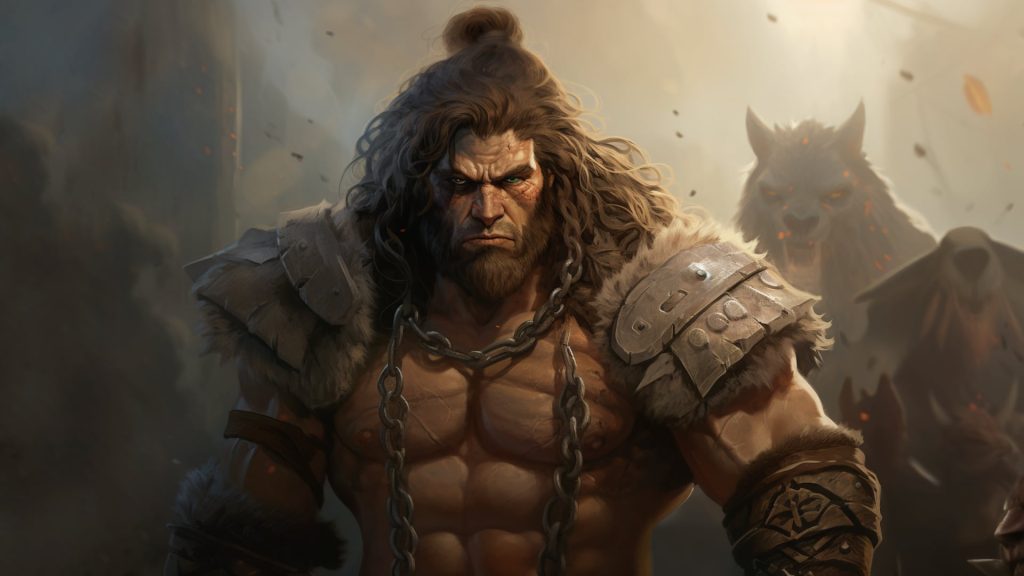
Being a MAD class there isn’t a lot of room in your early ASIs for feats, meaning a feat has to work very well for you or be generally really appealing to score well here. Feats that increase your durability and damage will take priority, whilst feats that provide, or enhance, spellcasting will not due to the clash with Rage.
Here are some examples of strong feat choices for a Barbarian:
Great Weapon Master 5 – The chance for +10 damage on a hit and a bonus action attack on a kill or crit make it easy to see why this is one of the stereotypical ‘must haves’ for a damage-orientated Barbarian. Whilst you certainly don’t need this feat to do good damage, it certainly helps, letting you use Reckless Attack to help offset the -5 penalty to your heavier-hitting attacks.
Polearm Master 5 – If you’re happy to use a polearm this can add a significant amount of damage. The bonus action attack allows you to get more out of your Rage damage bonus, and the opportunity attack on creatures entering your range allows you to more effectively deter from moving around you if you have a reach weapon. An excellent damage option for a Barbarian.
Sentinel 5 – An excellent feat for protecting your party, this allows you to lock down the enemies you charge towards, rather than them just walking away from you to the squishier spellcasters behind you. This pairs well with Polearm Master by giving you the ability to stop a monster in their tracks as they enter your reach. Note: using this feat with a reach weapon is a double-edged sword as it allows you to attack, and hopefully reduce the speed of, a creature further away, but it also allows creatures to move around you more before prompting an attack for leaving your reach.
Orcish Fury [Half-Orc] 5 – +1 in your main stats, a tiny burst of damage once per short rest, and making the already great defensive Relentless Endurance with an offensive twist? An outstanding feat that makes the other races jealous.
Crusher 5 – Resourceless control, increasing your core stat, and making your critical hits even nastier? Yes, please!
Barbarian DnD 5E Multiclassing Guide

In this section of Barbarian DnD 5E guide, we’ll review each class in terms of how well they multiclass with Barbarian, mentioning how many levels and what subclass (if any) would work best. The ratings take multiclassing prerequisites into consideration; if a multiclass will require you to have a 13 in a stat other than Str, it will likely receive a lower score unless the stat is one you would already have at 13 or higher, for example, Dexterity that you need for your AC.
General multiclass tips for the Barbarian:
- With Rage preventing you from casting, or concentrating on, spells it’s best to evaluate spellcasting multiclass choices based on class abilities and spells that last longer than a minute without needing concentration. An example of an ability that a Barbarian might want is the Divine Soul Sorcerer’s Favored by the Gods, and an example of a spell is Longstrider.
- It’s normally okay to take a dip at first level for most classes, however, this would lose the maximum value of the d12 Hit Die. It’s recommended to take a dip after 5th level so you have Extra Attack and Fast Movement, but you should at least wait until you have three levels of Barbarian. This gives you your subclass, third Rage per day, and a solid base of hit points.
- To gain the full benefits of Rage and Reckless Attack you need to use Strength as your attack modifier, so class dips that rely on using other modifiers for attacking are best avoided. Note: If you’re considering a Rogue dip, you can still use Sneak Attack as it only requires you to use a finesse weapon, not that you also use Dexterity for the attack.
- Barbarians have the largest size Hit Die and partially rely on their larger pool of hit points for their durability, this means that any class you multiclass into will give you fewer hit points than staying a straight Barbarian. This isn’t very impactful if you take a level or two in a d10 class like Fighter, but with larger dips, particularly in d8 and d6 Hit Die classes you will have a significantly less HP than you were proportionately used to before the dip. This is reinforced by the resistance that Rage gives you, which effectively doubles the value of each hit point.
- Features that increase your damage, critical hit range, and durability are the most desirable things to pick up.
Artificer 1 – Being able to make your own magic weapons would be great, but that requires two levels and an Intelligence of 13 which is a very steep cost and why this class should generally be avoided as a multiclass. If you do take enough levels in Artificer to gain a subclass, Armorer is highly recommended, specifically using the Guardian model. This will give you a small number of temporary hit points, but more importantly, the Thunder Gauntlets will give you a great incentive for enemies to hit you not your squishier friends.
Bard 1 – The primary benefits of this class are spellcasting and Bardic Inspiration, both of which are heavily reliant on your Charisma modifier. Whilst you can afford the prerequisite to multiclass into Bard, you can’t afford to be good at what you get from it without heavily compromising on your Barbarian stats. If you get far enough into this class to gain a subclass, the best choice is the College of Swords to gain a Fighting Style and Blade Flourish to weaponize the few Bardic Inspiration dice you have.
Cleric 3 – Wisdom is a good tertiary stat to have, making the prerequisite easy and low cost to achieve, the Cleric spell list provides healing options to let you take care of your own healing after combat, and offers Shield of Faith to increase your durability whilst not Raging. Recommended Domains are War for the bonus action attack ability and Guided Strike Channel Divinity, and Forge for giving yourself a +1 weapon or suit of armor with only a one-level dip. No more than two levels of Cleric are recommended.
Druid 2 – In general this is not a particularly good multiclass, as you only get spellcasting at 1st level, making it a larger level investment by default than the Cleric. There is one standout Druid multiclass that is particularly popular, however, and that is the Moon Druid with a Bear Totem, affectionately known as the Bearbarian. By using Wild Shape and Rage, you can take 136 points of damage every short rest without losing any of your Barbarian hit points, by simply being a brown bear in fights. This works on multiple levels, with Unarmored Defense raising the AC of most Wild Shape forms, Fast Movement increasing their movement speed, and Extra Attack giving them more damage.
Fighter 5 – You’ll already meet the prerequisites and almost every level brings you something useful, so try and set an expectation for how many levels you want to take. One level will give you a small combat heal with Second Wind, which is made more effective by resistance, and a Fighting Style of your choice which can help enhance any kind of Barbarian you want to play. Two levels will grab you Action Surge, which represents a huge damage increase, and three levels will get you a subclass. Some recommended subclasses include Battle Master for maneuvers that can add damage and accuracy to your attacks and Samurai, which would give you temp hp and advantage on all your attacks for a round three times per long rest, without giving the monsters advantage!
Monk 1 – The synergy here is very low, you already want a 14 Dex, but the Wis requirement is steep when one of the main benefits, using Dexterity for your attacks, you won’t actually want to use and you will have to forgo the option of armor and a shield altogether. The Monk having a lot of core abilities that cost Ki, but a dip providing you little Ki, is also a barrier. The only thing here is the Martial Arts bonus attack, which you could replicate with a lower cost by Polearm Master. If you really want to dip far enough into Monk for a subclass
Paladin 2 – The payoffs for dipping Barbarian are potentially high, with Lay on Hands giving you a good chunk of healing and Divine Smite giving you a burst damage option that you can use whilst Raging, and a Fighting Style. The stumbling block is needing at least two levels of Paladin to get any real benefit from it, whilst also needing at least a 13 Charisma. The first level of a Paladin dip will also feel a little dissatisfying, only getting 5 points of Lay on Hands and likely 2-3 uses of Divine Sense, so this is a dip more easily taken when starting a game at a higher level. If you take three levels, a highly recommended Oath is Vengeance, which will let you gain advantage on all attacks against one creature, once per short rest.
Ranger 1 – A similar story to Paladin, with you needing at least two levels to get real value but with less value there, at least Wisdom is an easier cost to pay than Charisma. There’s a decent selection of Fighting Styles on offer, and you can get some use out of Cure Wounds, Longstrider, and some utility spells but there doesn’t feel to be enough to warrant two levels. If you want to go three levels deep it can actually be very rewarding as the Ranger relies on subclasses for damage. Great choices here include the Gloomstalker for a bevy of benefits including an additional attack with bonus damage on the first round of every combat and the Swarmkeeper that offers the choice of damage or control. Overall more of a 1.5 than a flat 1.
Rogue 4 – You’ll likely qualify for this dip without having to purposefully do so, and there’s a significant amount of benefit for relatively little cost. You will lose two hit points per Rogue level you take and have to use a finesse weapon, but this is not an issue if you want to use two weapon fighting or sword and shield rather than a heavy weapon. The primary benefit you will get from Rogue is the Sneak Attack damage, which you can do reliably with the help of Reckless Attack, and Expertise if you intend to shove or grapple frequently. If you are okay taking a heavy dip into this class then 5th level will give you Uncanny Dodge, allowing you to halve damage you take from an attack, combined with Rage resistance this means you would only take a quarter of the original damage. For example, if you were hit for 67 damage by the BBEG, you’d actually only take 16! It’s not recommended to go further than 5 levels, with Swashbuckler being a recommended subclass for making Sneak Attack even easier to use.
Sorcerer 2 – This is a dip to avoid for the most part needing Cha as a prerequisite and primarily offering a large number of cantrips and a couple of 1st level spells. When looking at a Sorcerer dip you are primarily picking based on the subclass abilities That are offered, only two of which are recommended for a Barbarian: the Divine Soul’s Favored by the Gods which acts as either an offensive or defensive buff, and the Clockwork Soul’s Restore Balance which allows you to cancel out advantage or disadvantage with a reaction and scales with your proficiency bonus. These abilities are very potent and useful, just remember that you will be losing 3 hit points for this dip, no more than one level is recommended.
Warlock 3 – At first glance, this is a similar story to the Sorcerer, as you need Cha and just get spellcasting from the main class itself. However, you’ll gain access to Armor of Agathys which is fantastic for a Barbarian, in addition to a subclass ability. If you are willing to take a second level Eldritch Invocations open up a lot of potential benefits, including at-will temporary hit points from Fiendish Vigor and the ability to see through magical and nonmagical darkness within 120ft with Devil’s Sight. For your Otherworldly Patron, there are a few options that work well with a Barbarian but particular recommendations are: The Genie would give you a damage bonus to one attack per turn equal to your proficiency bonus and a safe place for you to rest or store items, the Celestial provides you with a small pool of bonus action healing to use on yourself or your allies, and the Hexblade gives you all of the benefits of Hexblade’s Curse (additional damage, an expanded critical hit range, and a small heal if the creature dies). Only two levels are generally recommended for a Barbarian, but it is worth noting the significant endurance that can come from combining the Celestial patron, with the Pact of the Chain and the Gift of the Ever-Living Ones invocation to maximize the bonus action regeneration Healing Light provides.
Wizard 1 – A multiclass to be avoided in general between its d6 Hit Die, Int requirement, and only spellcasting as a benefit from the first level. If you are interested in certain spells from the Wizard list you would be best looking to see if you can get those spells from other classes, like the Sorcerer, or feats, unless you are interested in having a higher Intelligence for roleplay reasons. If you do take two levels in the class the War Magic subclass is easily the best choice for you, giving you a small bonus to initiative and Arcane Deflection. The downsides normally associated with Arcane Deflection won’t affect you as you won’t be casting spells, but +2 to your AC or +4 to a saving throw is a fantastic at-will defense.
Are you feeling the burn or have you booked your first anger management session? If you enjoyed this Barbarian DnD 5E guide and found it helpful, comment below, and check out our other DnD 5E class guides. Until next time, may your crits be brutal and your battle roar super Saiyanesque.
